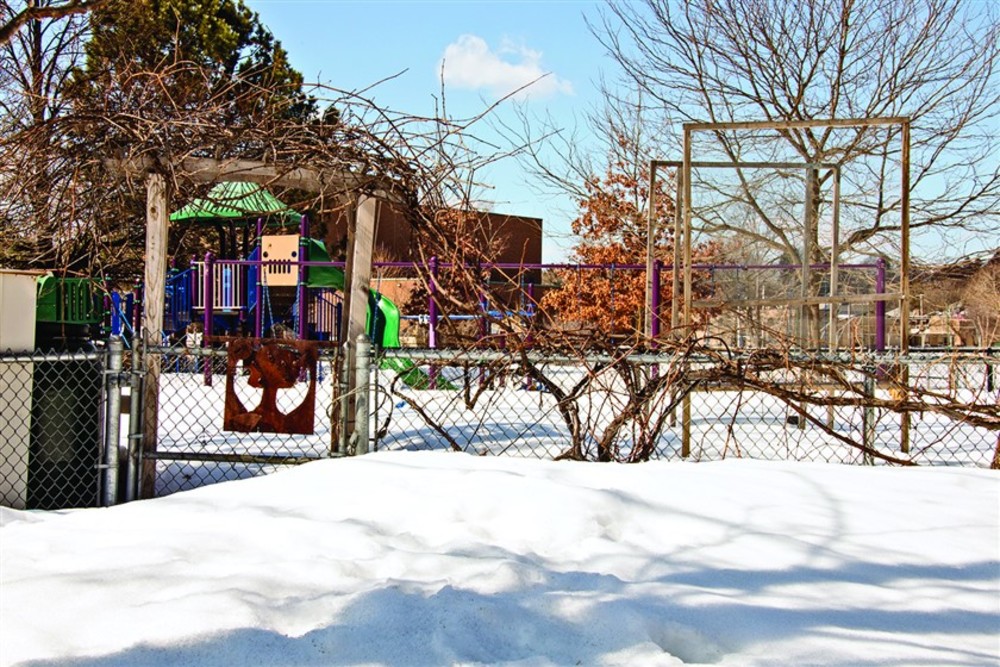After the winter of our discontent
Gardeners, heed these tips
 The Sessions Street Community Garden in Providence awaits the spring thawTo state the obvious, this winter took a toll on you. You had to postpone trips, reschedule appointments and schedule new ones (your poor back didn’t appreciate the strain of repeated shoveling). You have spent more money than you care to admit fixing broken furnaces, cleaning up the damage done by burst pipes and paying for particularly challenging snow removal. You have cooked all the soup you ever want to cook, watched all the reruns of “The Golden Girls” you ever want to watch and even caught up on your ironing. Now, you had the luxury of staying inside a warm house (unless you were the one with the furnace problem), and you’re still frustrated. Think about how your plants might feel. Find out just what you can do to help them get out of the winter rut.
The Sessions Street Community Garden in Providence awaits the spring thawTo state the obvious, this winter took a toll on you. You had to postpone trips, reschedule appointments and schedule new ones (your poor back didn’t appreciate the strain of repeated shoveling). You have spent more money than you care to admit fixing broken furnaces, cleaning up the damage done by burst pipes and paying for particularly challenging snow removal. You have cooked all the soup you ever want to cook, watched all the reruns of “The Golden Girls” you ever want to watch and even caught up on your ironing. Now, you had the luxury of staying inside a warm house (unless you were the one with the furnace problem), and you’re still frustrated. Think about how your plants might feel. Find out just what you can do to help them get out of the winter rut.
Andy Radin, who works at the University of Rhode Island Cooperative Extension, part of URI’s College of the Environment & Life Sciences which “helps people to improve their lives and communities by extending university-based research for the benefit of families, farms and the environment,” was happy to share some advice on gardening in the coming spring. First, he would like to emphasize that plants are resilient and put you at ease by making you understand that “there’s nothing wrong with a good strong winter for garden soil.”
Quite the opposite. He says that frost and snow melt work their way into the ground with alternate freezing and thawing, loosening and aerating the soil. This means that rain water infiltration and air movement are improved. Those who must worry about something despite the positive prognosis shouldn’t despair – not all is lost. They can still lose sleep over perennials, which will likely suffer some winter dieback, according to Radin. But knowing how diligent you are, you probably mulched your herbaceous perennials prior to the frost, so they should be resting comfortably under their covering. Still not satisfied with sitting still and want something to do to feel like you’re saving your garden? Consider the following tips.
What you should have done before the winter
to reduce damage:
• Selected plants that can withstand New England winters.
• Placed burlap or plastic physical barriers on the windward side of recently planted trees.
• Avoided fertilizing or pruning in late summer as late season growth is more fragile.
• Soaked the soil two inches deep and allowed it to dry between waterings to encourage deeper rooting.
• Refrained from frequent shallow sprinklings as surface roots are susceptible to injury.
• Used mulch to conserve soil moisture, keep temperature steady and reduce premature budding.
What you can do now:
• Brush off accumulated snow from branches to prevent breakage.
• Prune out any bare branches if blighted and if browned buds and leaves drop off and new ones fail to grow.
• Avoid attempting to remove ice from shrubs out of fear of breaking the brittle branches.
What to do in April:
• Pull out weeds and cover bare spots with plastic sheets or mulch that’s four inches high.
• Reduce rot by keeping mulch a few inches away from stems and tree trunks.
• Rake the garden beds before spring flowers start growing.
• Compost whatever you raked out to keep your garden free of weeds and fertilized.
• Turn over the soil in your vegetable garden and rake debris.
• Cover garden beds with manure.
• A couple of weeks before planting, add lime and cover beds to prevent runoff during rain.
• Clear drainage ditches and compost the carbon-rich refuse.
• Repair raised beds, trellises and fences.
Think you’re ready for planting?
• First, plant lettuce, spinach, leeks and peas as they prefer the cold to the heat.
• Next, plant onions, kale, radishes, potatoes and turnips. Include broccoli if you must.
• Cover seedlings if frost is expected overnight.
• If, along with your potatoes, you decided to plant cabbage, cover plantings to protect them from moths.
• Plant summer blooming bulbs: lilies, crocus, daffodils and gladioli.
Don’t forget about the details:
• Divide perennials; clear and mulch their beds.
• Use stakes for sprouting perennials, steering clear of the roots.
• Prune shrubs and fruit trees; apply horticultural oil sprays.
• Remove stakes and relax tree wires from fall planting.
• Transplant shrubs you’d like to move before they leaf out.
Enjoy the wonders of spring.
IRINA MISSIURO is a writer and editorial consultant for The Jewish Voice.







